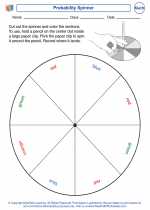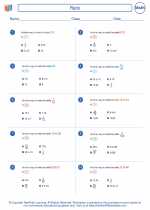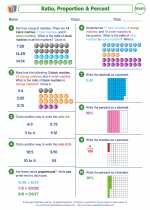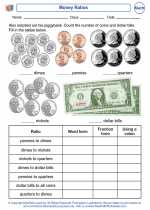Adjacent Angles
Adjacent angles are angles that have a common vertex and a common side. In other words, they are angles that share a side and a vertex, but do not overlap.
When two adjacent angles add up to 90 degrees, they are called complementary angles. When they add up to 180 degrees, they are called supplementary angles.
Here are some key points to remember about adjacent angles:
- Adjacent angles share a common vertex and a common side.
- They do not overlap.
- Complementary angles add up to 90 degrees.
- Supplementary angles add up to 180 degrees.
Examples:
Let's look at some examples of adjacent angles:
- Angle 1 and Angle 2 are adjacent angles because they share the common vertex A and the common side AB.
- Angle 3 and Angle 4 are also adjacent angles because they share the common vertex B and the common side BC.
Study Guide:
Here are a few steps to help you identify and work with adjacent angles:
- Identify the common vertex and common side shared by the two angles.
- Determine if the angles do not overlap and form a straight line.
- If the angles form a right angle (90 degrees), they are complementary angles. If they form a straight line (180 degrees), they are supplementary angles.
Remember to practice identifying and working with adjacent angles to become more comfortable with the concept.
[Adjacent Angles] Related Worksheets and Study Guides:
.◂Math Worksheets and Study Guides Fifth Grade. Ratio
Study Guide Ratio
Ratio  Activity Lesson
Activity Lesson Probability Spinner
Probability Spinner  Activity Lesson
Activity Lesson Easy Money
Easy Money  Worksheet/Answer key
Worksheet/Answer key Ratio
Ratio  Worksheet/Answer key
Worksheet/Answer key Ratio
Ratio  Worksheet/Answer key
Worksheet/Answer key Ratio
Ratio  Worksheet/Answer key
Worksheet/Answer key Ratio
Ratio  Worksheet/Answer key
Worksheet/Answer key Ratio
Ratio  Worksheet/Answer key
Worksheet/Answer key Ratio
Ratio  Worksheet/Answer key
Worksheet/Answer key Ratio, Proportions and Percent
Ratio, Proportions and Percent  Worksheet/Answer key
Worksheet/Answer key Money Ratios
Money Ratios  Worksheet/Answer key
Worksheet/Answer key Animal Ratios
Animal Ratios  Vocabulary/Answer key
Vocabulary/Answer key Ratio
Ratio 

 Activity Lesson
Activity Lesson
 Activity Lesson
Activity Lesson
 Worksheet/Answer key
Worksheet/Answer key
 Worksheet/Answer key
Worksheet/Answer key
 Worksheet/Answer key
Worksheet/Answer key
 Worksheet/Answer key
Worksheet/Answer key
 Worksheet/Answer key
Worksheet/Answer key
 Worksheet/Answer key
Worksheet/Answer key
 Worksheet/Answer key
Worksheet/Answer key
 Worksheet/Answer key
Worksheet/Answer key
 Worksheet/Answer key
Worksheet/Answer key
 Vocabulary/Answer key
Vocabulary/Answer key

The resources above cover the following skills:
Algebra (NCTM)
Use mathematical models to represent and understand quantitative relationships.
Model problem situations with objects and use representations such as graphs, tables, and equations to draw conclusions.